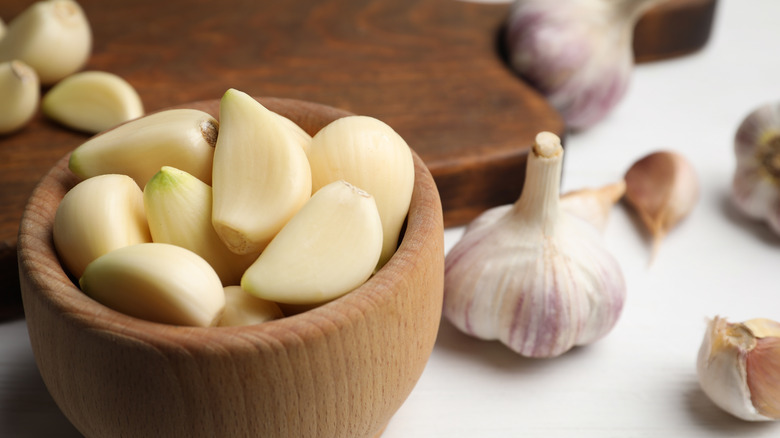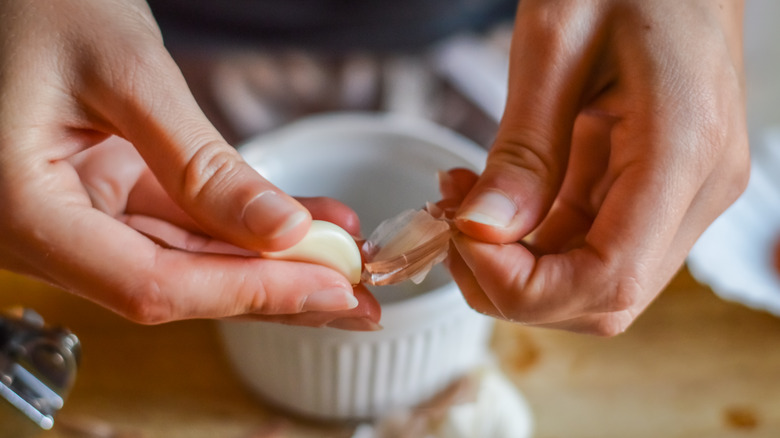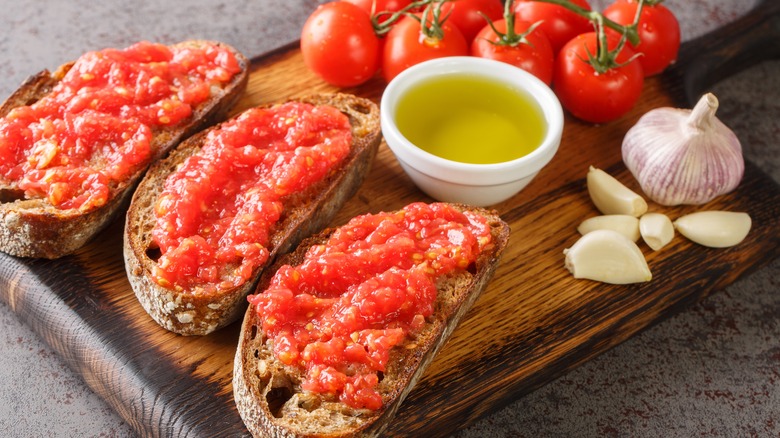Rub Your Plates And Bowls With Garlic And Thank Us Later
It's time to embrace garlic's sticky, aromatic nature to season your plates — yes, your literal plates. The allium already does the heavy lifting in vinaigrettes, pestos, and sauces. You can control and amplify its savory pungency with the touch of a clove to ceramic. And on the flip side, those averse to the harsh ingredient can moderate an intense meal by adding aroma to their bowl and reducing the crushed cloves in the recipe.
The idea is simple. Cut raw cloves in half and rub them along the surface of your dinner plate, bowl, or baking dish, just as you would use butter to grease a cake tin. The aroma will seep into the food as it sits, but the small quantity will prevent it from overpowering the taste of your dinner. Dressed salads, in particular, will absorb the sticky coating and brighten.
This technique is especially popular with salad bowls, but you can also apply the idea to plates and cups of soup, too. Cooked foods like steak, broccoli, and mashed potatoes come alive with the teasing aroma, as does a punchy salad or mild minestrone. If your dish contains the bulb, chances are, it will taste better served — and scraped off — a plate that incorporates it, too.
Understanding and harnessing garlic's pungency
The more garlic is chopped and handled, the more it releases allicin, the allium's natural defense mechanism and the source of its trademark smell. That's why some recipes call for a simple slice to maintain a mellow flavor, while others rely on a garlic press to draw out the maximum in-your-face bite. Cooking subdues some of this compound, as does acid.
That's part of the reason a final swipe with a raw clove can gently refresh any pungency lost to roasting and emulsifying. Allicin is strongest in fresh cloves, which is why you won't be able to replicate the effects with powdered or jarred versions. You might be tempted to simply toss raw garlic into foods at the end of cooking or add a smear of paste to the plate, but that could quickly overwhelm and negate all your hard work. Stick with the table-side clove application.
And be mindful about the dishes you choose to swipe. As you may have noticed, the allium's odor will cling to just about anything—except metal. You can rub your hands on stainless steel to banish garlic smells, which is great for cleaning but will make this trick less effective if your salad bowl is made of the material. So, be sure to try out the tip on ceramic or wood dishes, and neutralize any lingering aromas with a scrub of baking soda.
Meals that benefit from a garlic rub
An easy application of this technique is during the appetizer course. The ingredients of Caesar salad, with its rich and fishy dressing, embrace the extra hint of garlic rubbed around the serving bowl or on individual plates. The more you mix the lettuce, vinaigrette, and the absolute best croutons for Caesar salad together, the better everything will taste. The same goes for soup, which benefits from ample contact with the enameled surface and is already an olfactory experience.
If zippy crostinis are more your style, you can double down on the garlic swipe by smearing both the plates and the food itself. Buttered toast, with its rough surface and caramelized exterior, scrapes off more flavor from the raw cloves. You can take a Spanish approach and create pan con tomate by finishing with grated tomato and drizzling with olive oil, or keep things simple with a topping of sliced avocado.
Once you start applying this technique, you'll notice it appear in unexpected places. The raw rub is a common step in making cheese fondue and potato dauphinoise. Cooks coat their pots with garlic before melting the cheese, and skim over pans with cloves before roasting prepared potatoes. This ensures the aroma penetrates without adding an astringent taste. You can mimic this when baking starchy casseroles, rice, and noodle dishes like lasagna and ziti.



